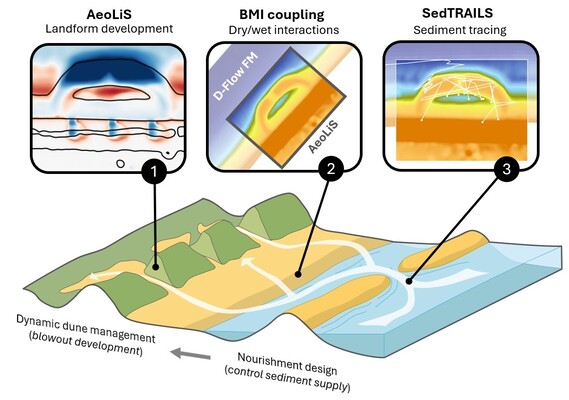B. van Westen1,2*, A.P. Luijendijk1,2 , S. de Vries2, S.G. Pearson2, M.A. de Schipper2,3
1 Deltares, The Netherlands; 2 Delft University of Technology, The Netherlands; 3 UNSW Sydney, Australia
* Corresponding author: Bart.vanWesten@deltares.nl
Introduction
Coastal dune dynamics can support adaptive responses to sea-level rise by widening the transition zone between beach and dunes, enhancing inland sand transport. Maintaining aeolian dynamics sustains sediment supply deeper into the dune system, which is crucial for preserving biodiversity while allowing dunes to grow with the sea. Since the 1990s, Dutch coastal policy has focused on maintaining the coastline position through nourishments. This has reduced the need for dune stabilization and created opportunities to reintroduce dynamics into the system. However, efforts to restore these dynamics (e.g., through artificial notches) have not always been successful. Excess sediment supply can stimulate marram grass growth, leading rapid blowout closure, limiting fresh sediment influx into the inner dunes.
This raises the question: can nourishments be designed to enhance dune mobility and sustain sediment connectivity? Existing tools primarily focus on single domains, lacking the capacity to assess cross-domain interactions. Understanding these interactions is essential for simulating how sediment supply from nourishments influences dynamic dune development. Addressing this challenge requires interdisciplinary tools (Figure 1) that integrate (i) subaerial landform evolution under supply‐limited conditions and (ii) marine-driven processes influencing sediment supply.
Objective and Methods
This study aims to demonstrate how recently developed numerical tools can be useful in designing nourishments to enhance dune mobility, ultimately showcasing their potential in designing interdisciplinary Nature-based Solutions. We use a combination of three numerical tools to examine a case study located along the Delfland coast (Figure 1).
Subaerial landform evolution is simulated using a recent version of AeoLiS (van Westen et al., 2024b), which incorporates supply-limited conditions and models landform evolution. This is coupled with Delft3D Flexible Mesh using a BMI-based framework (van Westen et al., 2024a) to represent marine-driven sediment transport and nearshore morphodynamics.
In our simulations, we evaluate two contrasting nourishment designs: (1) a conventional beach nourishment, where sediment moves freely from the waterline to the foredune, and (2) a lagoon-based nourishment, which initially restricts sediment supply, potentially extending the period of blowout development. The model results are analysed to quantify spatiotemporal variations in aeolian sediment supply at the dune foot, which are then correlated with blowout evolution. Finally, we employ SedTRAILS (van Westen et al., under review) to track sediment pathways and quantify the fraction of nourished material reaching the inner dunes, providing insight into how nourishment design influences sediment connectivity between the beach and inner dunes.
Results
Results from the simulated scenarios show that nourishment design can influence dune mobilization, as reflected in the simulated differences in blowout evolution. In the conventional beach nourishment case, high sediment supply accelerates embryonal dune formation, leading to rapid stabilization and closure of blowouts, which ultimately blocks sediment fluxes to the inner dunes. In contrast, the lagoon-based nourishment initially restricts sediment supply, allowing blowouts to remain active for a longer period before the lagoon fills. This extended phase of sediment limitation enables blowouts to develop further, establishing a more persistent pathway for aeolian transport into the hinterland.
While the scenarios are idealized, these findings suggest that controlling sediment supply constraints through nourishment design can enhance blowout longevity and connectivity between the beach and inner dunes. Additionally, these results demonstrate how the integration of AeoLiS, BMI coupling, and SedTRAILS can provide valuable insights for designing interventions across the dry-wet interface. This innovative approach underscores new opportunities for coastal engineers and scientists to incorporate ecomorphological interactions in the design and evaluation of Nature-based Solutions.

Conceptual overview of sediment pathways from a lagoon-based nourishment into the backdune, assessed using an interdisciplinary modelling approach: (1) AeoLiS for subaerial landform development, (2) BMI coupling for wet–dry interactions, and (3) SedTRAILS for sediment tracing.
References
van Westen, B., Luijendijk, A. P., de Vries, S., Cohn, N., Leijnse, T. W., & de Schipper, M. A. (2024a). Predicting marine and aeolian contributions to the Sand Engine’s evolution using coupled modelling. Coastal Engineering, 188, 104444.
van Westen, B., de Vries, S., Cohn, N., van IJzendoorn, C., Strypsteen, G., & Hallin, C. (2024b). AeoLiS: Numerical modelling of coastal dunes and aeolian landform development for real-world applications. Environmental Modelling & Software, 106093.
van Westen, B., de Schipper, M., Pearson, S., & Luijendijk, A. (under review). From source to sink: A Lagrangian approach for modelling coastal evolution. Manuscript under review.


